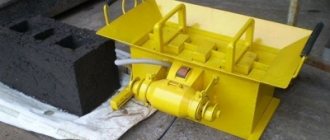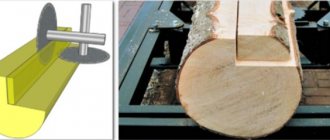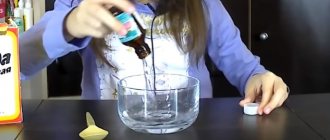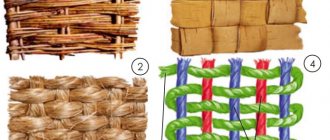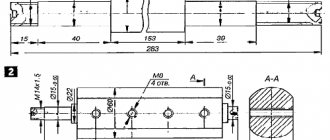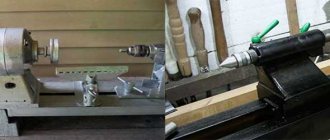It is believed that cinder block is excellent for the construction of residential buildings and other buildings, due to its availability and compliance with the required characteristics.
To further reduce the cost of the material, many begin to produce it themselves.
This can be done either using improvised means or using a special machine. The device is not cheap, but you can also build it yourself.
Description of the device
A vibrating cinder block machine is equipment that helps compact the mortar poured into molds . This is done so that there are no voids or air bubbles in the mass for making the block. The finished cinder block must fully comply with GOST, otherwise it cannot be used for building a house.
Important! Blocks that were made using a brick press always have better frost resistance, resistance to deformation, and strength than those that were made using other technologies.
The vibrating machine consists of several parts. In its lower part there is a frame where the vibrating table is located. It rests on rubber cushions. The vibrating table has several vibrators with adjustable strength.
The design has a backfill device for pouring concrete mixture . This is a tin container that allows you to pour concrete into the mold evenly and quickly. There is also a punch and a die.
The design includes a device for pressing the matrix with the pallet to the vibrating table. Vibrators for cinder blocks are equipped with electric motors and a drive.
Some vibrating machines use void formers. They are inserted into forms with concrete mixture and make holes in them. The output is a hollow cinder block.
What are they?
Machines for the production of cinder blocks are:
- automated stations;
- semi-automatic machines;
- manual equipment.
A fully automated machine is more suitable for enterprises that constantly sell cinder blocks. The productivity of such equipment is up to 1000 blocks per hour.
All you need to do is simply pour the cinder block ingredients into the container and press the start button. The mini-station will independently mix, pour, and compact stones ; the operator only needs to monitor the work. The advantage of such a vibrating machine is the lack of human intervention, the disadvantage is the high cost. Similar devices are produced by Bess.
Semi-automatic machines already require human intervention. Some operations here are automatic, but others will have to be performed manually. For example, in different configurations, the machine itself mixes the mixture for the stone, and the operator needs to lower the vibropress.
In other machines, the operator only participates in pouring the finished solution, and the rest is done by the vibrating table. The production of such machines is carried out by the Sibir company.
Manual equipment is considered the least productive, but it fully satisfies the needs for cinder blocks in private construction. The average cost of such a device will cost 200,000 rubles. A good representative is a device from VibropressStroy .
Reference! Depending on the type of block formation, machines can be mobile or stationary. The first ones are small in size and stones can be produced immediately on the construction site. Stationary equipment requires a lot of space, but its productivity is higher.
Principle of operation
All of the listed machines operate on a similar principle:
- The prepared solution is poured into a special container.
- The mixture is transported into the matrix.
- With the help of vibration, the mixture is leveled and compacted.
- If there are devices for voids, they are inserted into blocks with mortar and are strongly compacted under pressure and vibration.
- The matrix rises above the blocks and the finished mixture, already formed into blocks of the required size, is sent for drying.
The only difference between the devices is that in a fully automated machine all operations are performed independently. Even the mixing and transportation of the solution occurs automatically .
If the machine is manual, then the person must first prepare the slag mass in a concrete mixer, then pour it into molds, and then compact it well using a vibrating table. Again, you will have to carry the blocks to dry yourself.
Materials required for production
As mentioned above, cinder blocks are an artificial stone with a rectangular shape and strictly defined dimensions. The type and dimensional features are determined by the purpose. In most cases, these are blocks with technological voids, occupying about 30 percent of the volume and providing relatively low weight and low thermal conductivity of the material.
Depending on the purpose, there are several types of cinder blocks:
- Hollow or monolithic.
- Whole or half.
- Ordinary or facial.
- Load-bearing or partition.
Decorative (facial) models can be painted in different colors. Their front surface has a chipped, torn, grooved or polished structure. In most cases, this solution is intended for decorative purposes , for example, for arranging amazing hedges.
This building material contains binding elements - filler and water. The name refers to the presence of blast furnace slag, which was once used as an aggregate. Currently, it is practically not used , replacing it with other materials:
- granite screening;
- brick chips;
- fine-grained crushed stone;
- river gravel;
- sand;
- expanded clay;
- clay;
- wood sawdust.
Cement grade 300−600 is used as a binder. It is known that the higher the grade , the higher the density of the stone.
Since there is practically no strict recipe for creating the material, its properties and performance indicators are unique and depend on individual characteristics.
Industrial production differs from domestic production in one subtlety - the processing of the formed stone is carried out in a steaming chamber. Within a day, at a temperature of 80-100 degrees and humidity up to 100%, the material gains about 70% strength and is immediately suitable for construction. The strength indicators of factory models are twice as high as those typical for home ones. Nevertheless, homemade solutions are much cheaper than store-bought ones, and at the same time they are quite suitable for constructing structures.
How to make a vibrating machine at home?
If the machine is needed for individual production of blocks when building your own house, then there is no point in purchasing expensive equipment. You can try making it yourself .
Before you begin preparing tools and materials, you need to find the drawings. Such schemes can be found on the Internet on construction forums. There people share their experiences and talk in detail about the collection of equipment and its operation.
Necessary materials
To create a machine for the production of cinder blocks with your own hands, you need the following materials :
- galvanized metal sheet 3 mm thick;
- 1 meter of steel pipe with a diameter of 7-9 cm;
- steel strip 3 mm thick, 30 cm long;
- electric motor with power up to 1 kW.
A sheet of galvanized metal is necessary to create a matrix into which concrete and slag mixtures will be poured. The thickness of 3 mm is just right for these purposes.
The steel tube must be prepared for void formers . It is unlikely that self-production will produce only solid blocks. You can choose the diameter of the pipe yourself, depending on what diameter of the void you want to get at the outlet.
Note! Solid blocks are used to construct load-bearing walls, and cinder blocks with voids are used for internal walls and partitions.
The electric motor will be useful for arranging the drive, due to which the solution will be compacted in the molds.
Necessary tools and consumables
Consumables for assembling a vibrating machine will require a large amount of fasteners: screws, nuts, bolts, anchors. You also need to prepare tools :
- angle grinder or grinder;
- welding machine;
- vice;
- a set of keys.
It is also better to prepare screwdrivers and a screwdriver (if available) in advance - with the help of these tools you can assemble the machine much faster. For an angle grinder you need to choose a disc that can work on metal. You can’t do without a welding machine - the vibrating machine must be made with high quality and last throughout the entire construction phase.
If you have no experience with welding, then you shouldn’t risk it - this procedure requires special skills. In this case, it is better to hire an experienced welder and explain the task to him. You will need hex keys and others, so it is better to have a good set.
Step by step procedure
After all the materials, tools and consumables are ready, you can begin manufacturing the machine:
- At the first stage, you need to decide on the size of future blocks. This indicator must be written down in the drawing. The most common option is 200x200x400 mm.
- When making a matrix for blocks, you need to take into account the following point: the height of the matrix will be 50 mm higher than the height of the finished block. For manufacturing, a sheet of steel is cut using a grinder. You need to cut this sheet in advance, and also take care of the presence of partitions between the forms.
- Using a welding machine, the cut strips are welded together on the outside.
- Production of void former. The metal pipe is cut into lengths less than the height of the matrix by 5 mm. The device must have a cone-shaped shape; this can be achieved by clamping the pipe in a vice and welding it. The tubes must be blind on all sides; at the end they are connected to each other by welding.
- The void former is welded to the matrix or a removable structure is made.
- Bolts are attached to the outer long wall of the mold, onto which the electric motor is installed.
Do not forget that there must be a metal apron on the top of the matrix. At the final stage, the finished machine is placed in a frame, cleaned and painted.
What is the best way to fill the forms?
If you are setting up the production of cinder blocks at home, know that there is no universal composition; each master selects his own unique recipe, which is more suitable for a particular bathhouse and which depends on the existing slag. But the standard cinder block recipe is as follows: 7 parts slag, 2 parts sand and 2 parts gravel, 1.5 parts good cement (grade M400) and from one and a half to 3 parts water. The accepted dimensions of a cinder block are 39x19x20 cm, but dimensions of 40x20x20 cm are also used in private construction.
In addition to the slag itself, ash, other coal combustion waste, gravel, processed sawdust, perlite, stone and granite screenings, gypsum, broken bricks and the like are used as fillers for such blocks. For greater plasticity of the blocks, a plasticizer is also added - this is 5 grams per block, during vibration casting. For what? It is this substance that significantly increases the strength of the block, its frost resistance and water resistance, and eliminates cracks.
You need to measure the amount of water especially carefully: the blocks should not spread during removal. You can conduct the following test: if the solution crumbles when it falls to the ground, but comes together in your fist, this is what you need. By the way, concrete for the construction of a small bathhouse can be prepared manually, but for a more serious structure it is better to initially acquire an electric concrete mixer designed for a volume of 0.2-0.5 cubic meters.
Possible difficulties in the process
During the assembly process of the cinder block machine, errors and difficulties may arise :
- the vibrator is attached too loosely to the machine;
- there are no lids on metal forms;
- the finished product has not been painted;
- the tubes for the void formers are not welded on one side - then the solution will get there.
If you follow the instructions and select high-quality materials for the manufacture of the machine, then there will be no problems. During assembly, you can also use the services of professionals who can help with certain procedures.
Preparing a solution for cinder concrete
A concrete mixer is the best option.
Before we talk about how to make cinder blocks at home, let's consider preparing a solution for them. The solution for slag concrete blocks includes a filler, preferably slag remaining after the combustion of coal in the furnace, in an amount equal to seven parts by volume.
Coarse expanded clay sand - two parts, gravel, fraction 0.5 - 1.5 cm - two parts, cement, grade M500 - one and a half parts and water - three volume parts. But not only slag can be a filler; gypsum, expanded clay, ash, gravel, screenings of crushed stone, sand, brick waste and even processed sawdust can be used as such.
When using blast furnace slag as a filler, no unnecessary additives should be present: wood chips, earth or unburnt coal. Therefore, the slag must be sorted in advance and sifted using a special sieve.
If the filler is gypsum, then the components of slag concrete are taken in the following proportions: gypsum - one part, slag mixture - three parts and water. The solution is thoroughly mixed and used almost immediately.
This mixture is prepared within a maximum of six minutes. The slag mixture is pre-moistened. To prepare one cubic meter of solution, about 350 liters of water are used.
In order to make high-quality slag concrete blocks at home, a special plasticizer is added to the solution. As a result, the mixture becomes very plastic, and the blocks are strong, waterproof, frost-resistant and not brittle.
In addition to hollow ones, blocks can also be made solid. They are the strongest and most durable, and most often they are used to make the foundation. In contrast, hollow blocks are lightweight and have excellent heat-insulating and soundproofing properties.
Well, one more important property: cinder blocks can be colored if dyes are added to the solution, which can be chalk or crushed red bricks
Pros and cons of making your own
There are several advantages to making your own cinder block machine:
- reducing the cost of the construction process from homemade blocks;
- the ability to make a machine to suit your needs;
- the ability to equip the equipment with the necessary containers at your request;
- the ability to make a new matrix if it becomes unusable.
There are also disadvantages, including the length of time it takes to manufacture the machine and possible mistakes made due to inexperience.
Mixture composition
The production of slag blocks at home obliges the craftsman to adhere to a specific composition, as well as certain proportions of all components. Thus, the binding ingredient in this material is usually cement of a grade not lower than M400. As for the filling component, it can consist entirely of slag or be mixed. The last option is obtained by adding a small amount of crushed stone, sand (simple or expanded clay), crushed brick and fine expanded clay.
When making cinder blocks, the following proportions must be observed:
- 8-9 parts of the filling component;
- 1.5-2 parts of astringent ingredient.
For example, out of 9 parts, at least 6 are accounted for by this component, and the rest is made up of crushed stone and sand. In theory, when making it yourself, it is permissible to use concrete or brick scraps, screenings.
The standard proportions of cinder block are:
- 2 parts sand;
- 2 parts crushed stone;
- 7 parts slag;
- 2 parts of Portland cement marked M400.
As for water, it is customary to add it in an approximate ratio of 0.5 parts. The result is a semi-dry solution. To ensure its high quality, you need to take a small handful and throw it on a hard surface. If the thrown lump crumbled, but under compression conditions regained its previous shape, then the composition can be considered suitable for further use.
If you plan to obtain colored cinder blocks, then the recipe is supplemented with colored chalk or brick chips. To increase the strength characteristics of this material, special plasticizers are used. In some cases, they resort to adding gypsum, ash or sawdust.
Features of doing business related to the production of cinder blocks
According to statistics from recent years, one of the most profitable niches for starting a business is the production of cinder blocks. To open production, it is not necessary to obtain appropriate certificates for both equipment and finished products.
Since the volume of construction of private houses and cottages in our country is constantly growing, inexpensive building materials of appropriate quality are sold in large quantities. In this regard, a business producing wall stone blocks can regularly generate good income.
When starting to implement your own business project, you need to go through a simple procedure for opening a small business, and also be sure to register for membership in a self-regulatory organization that unites small businesses in the construction industry. The center’s specialists provide support in obtaining an SRO certificate and provide training to employees who will work at the enterprise.
Price for machines
On the construction market and in advertisements on the Internet you can find many options for professional equipment for producing cinder blocks.
The standard kit includes a vibrating machine with molds for 4 blocks, a concrete mixer (300 l) and wheelbarrows (2 pcs.) for feeding and transporting the mixture. Such an installation will cost an average of about 170,000 rubles in Russia. There are options for 900,000 rubles, and there are also options for 70,000 rubles. and even for 35,000 rubles.
In general, it all depends on the performance of the equipment, its release date, mobility, functionality and configuration. It’s worth adding to the price delivery across Russia to your destination.
